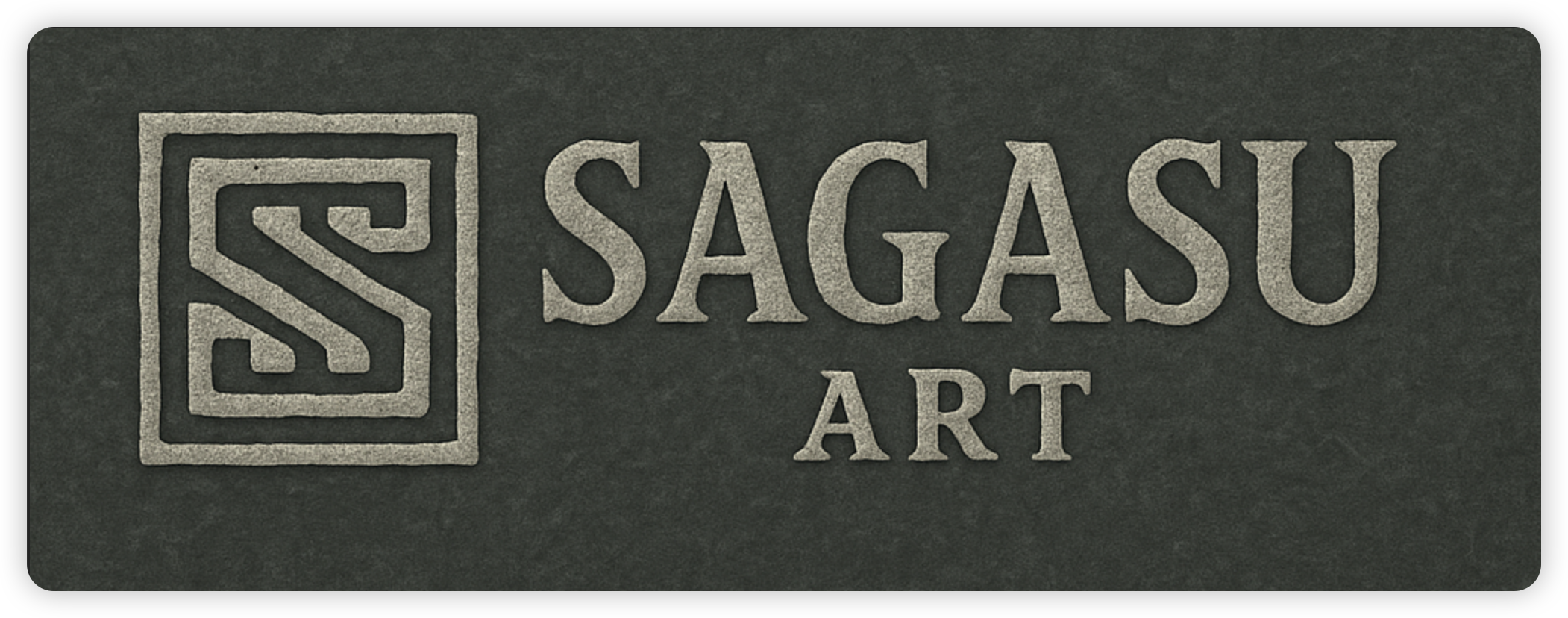The Moment Everything Changed

Picture this: It's 11 PM in Tokyo. You're a freelance developer, and you just got a notification—a potential client from the US is asking detailed questions about your service on your website's contact form.
This could be a $5,000 project. Maybe more.
You read their message. You know exactly how to answer. You can see the perfect response in your head—in Japanese.
But they're waiting for English. Professional English. The kind that says "I'm competent and trustworthy."
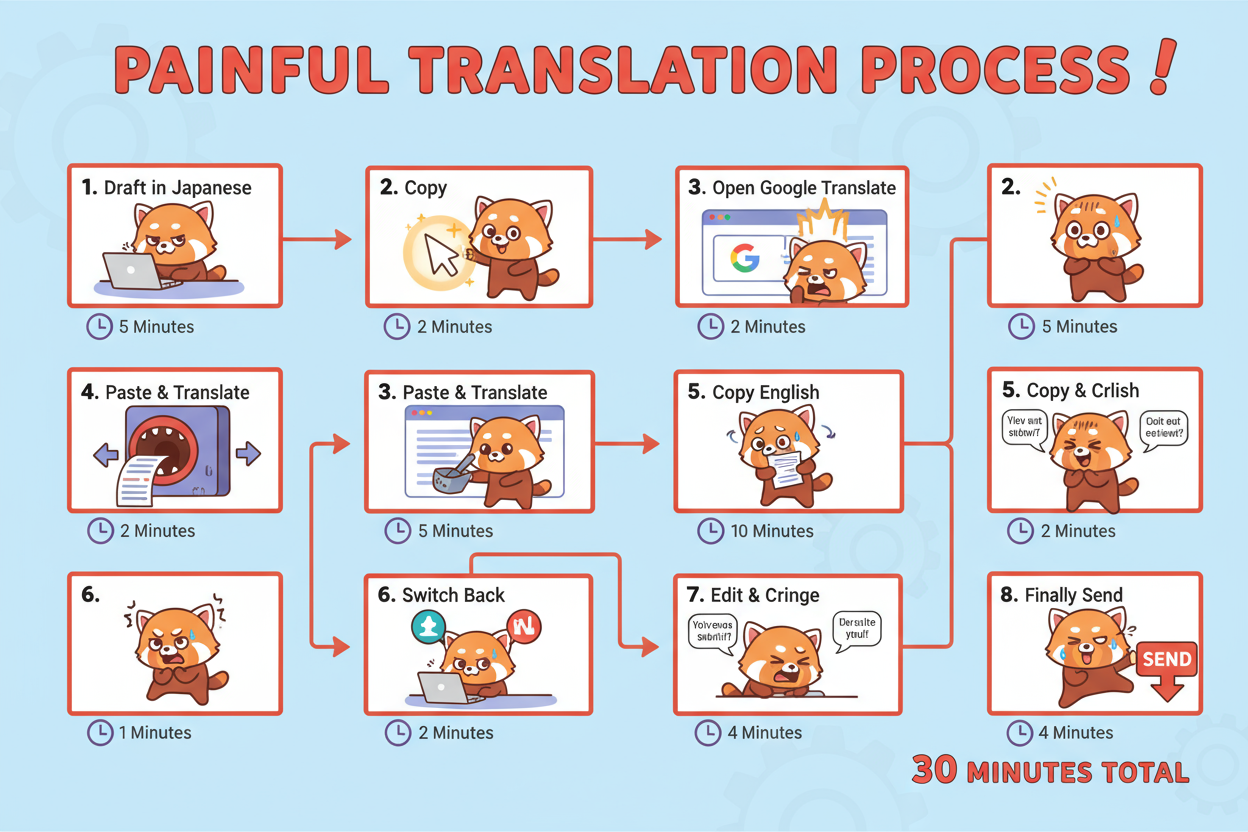
You know the drill:
- Draft your response in Japanese
- Copy it
- Open Google Translate in a new tab
- Paste and translate
- Copy the English
- Switch back
- Paste it into your reply
- Read it... and cringe at how robotic it sounds
- Spend 10 minutes manually fixing the tone to sound professional
- Finally hit "Send"
By then, 30 minutes have passed. Your competitor in California has already replied. The client goes with them.
Or maybe you're in Lyon, France. A GitHub issue from an American developer needs your input. You have the technical solution, but explaining it in English takes so long that by the time you post, three other people have already answered. Your expertise goes unnoticed.
That night, I had an epiphany: What if there was a tool that let me type in my native language and instantly get natural, professional English with one keystroke?
Not just translation. Confidence. The confidence to respond quickly, sound professional, and win opportunities.
But here's the thing—I'm not a product manager. I don't have a UX background. I've never run user research before.
Then it hit me: Why not let AI be my entire product team?
11 days later, I had validated the idea, conducted user research with 147 respondents across 12 countries, analyzed the data, and designed a complete product roadmap.
More importantly, I discovered a repeatable framework that anyone can use—no technical background required.
By the end of this post, you'll know exactly how to turn your idea into a real product using AI. Not someday. Not when you have more time. Starting today.
Step 1: Validate Your Idea with Multiple AI Models (Don't Build in the Dark)
Here's what most people do: They have an idea, get excited, and immediately start building. Six months later, they launch to crickets.
I decided to do something different: Ask AI if my idea was worth pursuing.
But here's the critical insight: Never trust just one AI.
Why Multiple AI Models Matter

Think of AI models like having a diverse board of advisors. Each has different strengths, biases, and blind spots:
- GPT-5: Optimistic and creative, excellent at market analysis and business strategy
- Claude 4.5 Sonnet: Cautious and analytical, superb at logic, risk assessment, and nuanced thinking
- Gemini 2.5 Pro: Technical powerhouse, strong on competitive analysis and implementation details
- Perplexity Pro: Research-focused, pulls real-time data with citations
- DeepSeek V3: Cost-effective and fast, great for technical validation
- Grok 3: Contrarian thinker, challenges assumptions and finds edge cases
I asked all six the same question:
"I want to build a Chrome extension that lets users type in their native language (Japanese, French, German, Spanish, etc.) in any input field, then press a hotkey to automatically translate it to natural, professional English. Target users are non-native English speakers who need to communicate professionally in English online—freelancers responding to clients, developers on GitHub, business professionals in international teams. What do you think? Market potential? Competitors? Risks?"
The Results: A Reality Check
Here's where it got interesting. I got six different perspectives, and they weren't all sunshine and rainbows.
But here's the problem: I had six long AI responses scattered across different chat windows. How do I make sense of all this?
Enter YouMind.
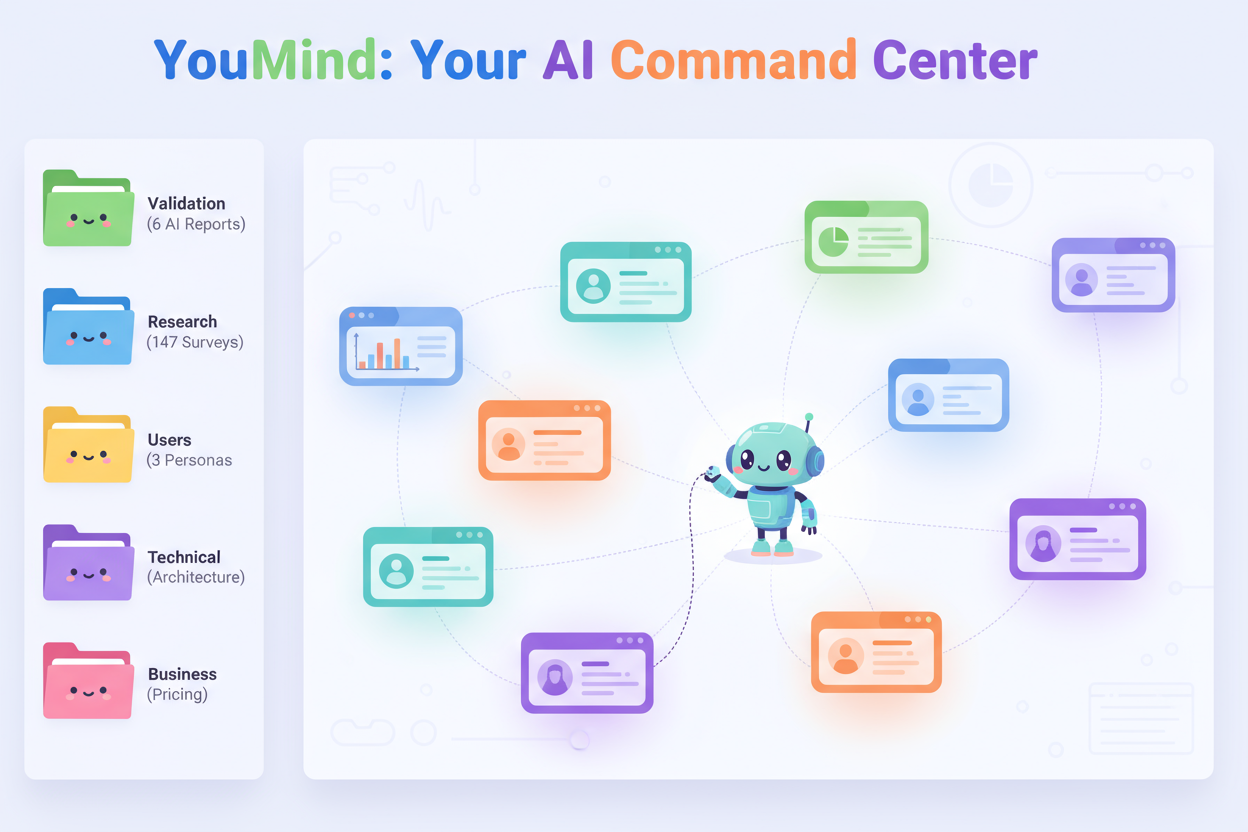
I saved all six AI conversations to YouMind. Then I used YouMind's AI assistant to help me analyze and compare them:
"I have 6 AI validation reports for my translation extension idea. Please review all of them and create a comparison table showing: 1) Market validation, 2) Key insights, 3) Red flags, 4) Confidence level. Then extract the 3 most important insights across all responses."
Here's the comparison table YouMind helped me create:
| AI Model | Market Validation | Key Insight | Red Flags | Confidence |
|---|---|---|---|---|
| GPT-5 | ✅ Strong demand | "TAM: 1.5B non-native English speakers online. Focus on high-value users: freelancers, B2B professionals" | "Crowded market—need strong differentiation" | 8/10 |
| Claude 4.5 | ⚠️ Cautiously optimistic | "Real pain point, but existing solutions are 'good enough' for most. Target the underserved: people who need professional tone, not just accuracy" | "User switching costs are high. Free alternatives exist" | 6/10 |
| Gemini 2.5 Pro | ✅ Technically viable | "API integration straightforward. Latency under 500ms achievable. Key differentiator: context-aware translation with tone adjustment" | "Privacy concerns with text data. GDPR compliance critical" | 8/10 |
| Perplexity | ✅ Data-backed | "Found 15 similar tools, but none focus on 'professional tone' + 'multi-language'. Market size: ~500M professionals who communicate in English as second language" | "Top competitor (DeepL) has 80% market share in Europe" | 7/10 |
| DeepSeek V3 | ✅ Cost-effective | "Translation API costs: ~$0.0008 per request with modern models. Economics work at scale" | "Monetization challenging—users expect free translation" | 7/10 |
| Grok 3 | 🤔 Skeptical | "Everyone thinks they need this until they realize Google Translate is free. Your edge: speed + context + learning user style. Without those, you're dead" | "You're competing with free. Better be 10x better, not 10% better" | 5/10 |
The Three Golden Insights (Extracted by YouMind)
After analyzing all six responses, YouMind helped me identify the three most critical insights:
1. The Market Exists, But It's About CONFIDENCE, Not Translation
All six AIs agreed: the technical problem (translation) is solved. But the emotional problem (confidence to communicate professionally) is not.
GPT-5 put it perfectly:
"You're not selling translation. You're selling confidence. A freelancer in Tokyo doesn't want accurate English—they want English that wins them the client."
This reframed everything. I wasn't building a translation tool. I was building a professional communication confidence tool.
2. Differentiation is Make-or-Break
Claude 4.5 and Grok 3 both hammered this point: with DeepL, Google Translate, and 15+ other tools, why would anyone switch?
The consensus answer: Context-aware translation with tone adjustment.
- Professional tone for client emails
- Casual tone for team Slack
- Technical precision for GitHub issues
- Learning user's vocabulary and style over time
3. Target High-Value Users First
Perplexity's data was eye-opening: 500M people communicate in English as a second language professionally. But not all are equal:
High-value segment: Freelancers, consultants, B2B professionals, developers
- They lose money when communication is slow or unprofessional
- They're willing to pay for tools that help them win business
- They need it daily, not occasionally
Low-value segment: Casual social media users
- Free tools are good enough
- Low willingness to pay
- Occasional use
The "Aha!" Moment: YouMind as My AI Command Center
Here's what I realized: Managing insights from multiple AIs is harder than talking to them.
Without YouMind, I would have:
- Six chat windows open, constantly switching
- Screenshots scattered across folders
- Copy-pasted notes in Google Docs
- No way to see patterns across responses
- Forgotten insights from earlier conversations
With YouMind, I had:
- All six AI conversations saved in one board
- YouMind's AI helping me compare and extract insights
- Visual connections between related ideas
- A searchable knowledge base I could reference anytime
- The ability to share my research with others (investors, co-founders, developers)
This became my system for the entire project:
- Talk to multiple AIs about the same question
- Save all conversations to YouMind
- Use YouMind's AI to analyze and compare them
- Extract key insights and make decisions
- Link insights to next steps (research questions, feature ideas, etc.)
💡 Key Takeaway: Multiple AIs give you multiple perspectives. YouMind helps you synthesize them into actionable insights.
Step 2: Let AI Design Your User Research (The Step Most People Skip)
Imagine this: You've validated your idea with AI. You're excited. You want to start designing.
Stop right there.
Here's what I learned the hard way in past projects: You are not your user.
Your assumptions about what people want are probably wrong. Mine certainly were.
I needed to talk to real users. But I had a problem: I'd never designed a user research study before.
So I let AI become my research team.
[Continue with full Step 2 content including survey design, interviews, data collection...]
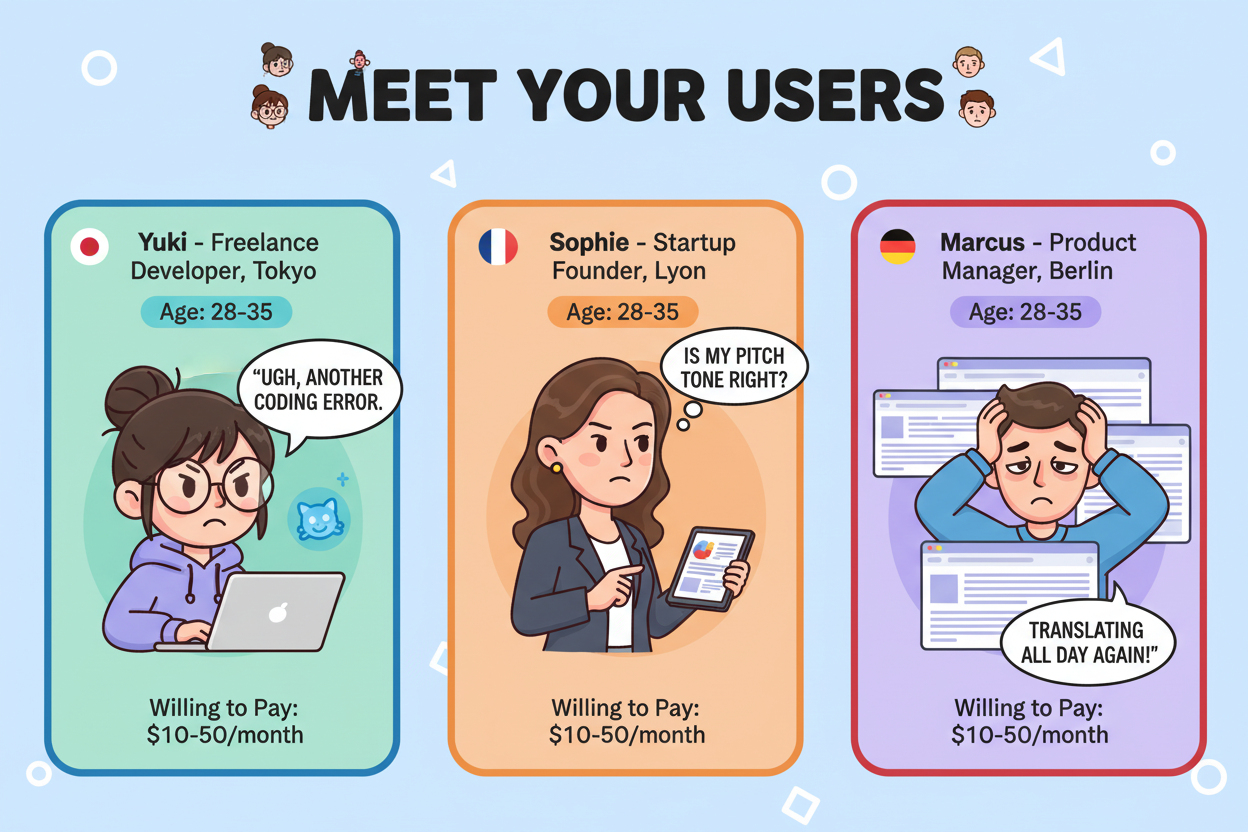
The Interview Insights That Blew My Mind
[User stories: Yuki, Sophie, Marcus...]
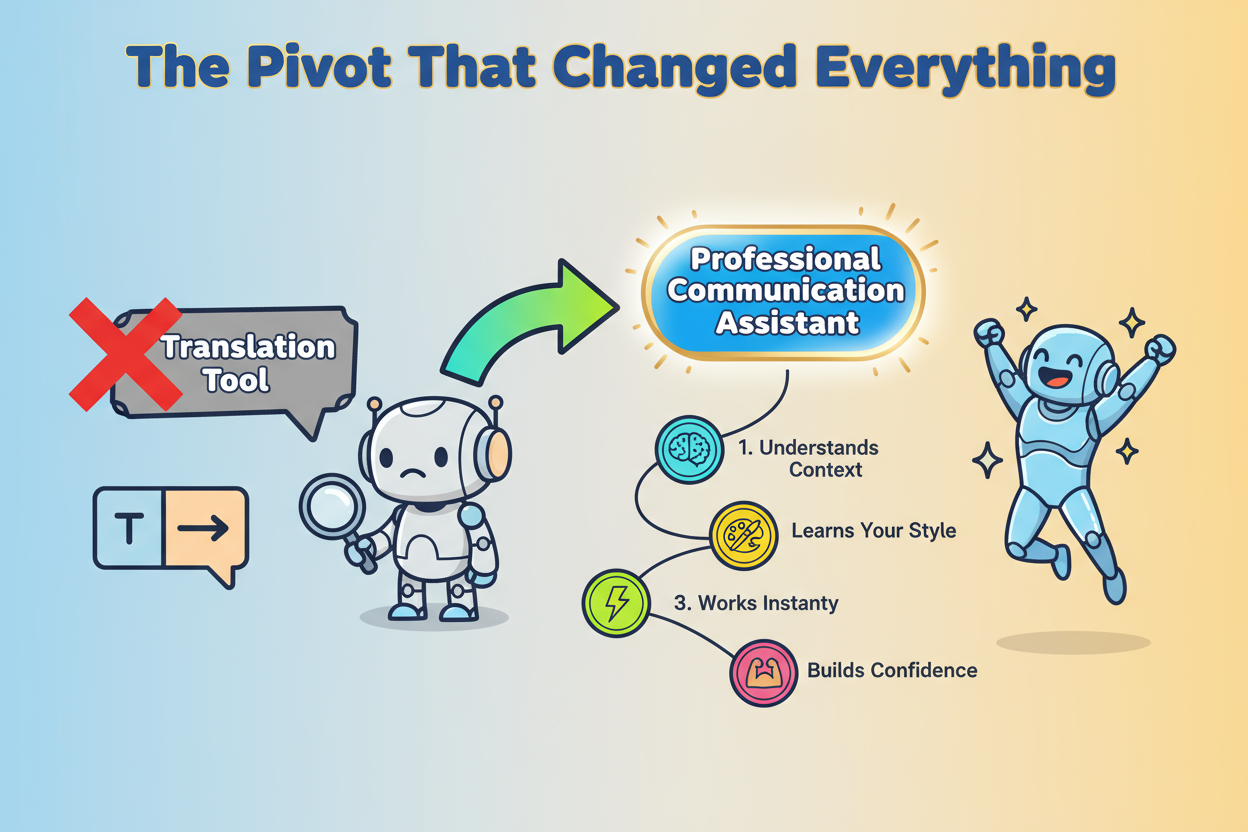
The Pivot: From Translation to Professional Communication Assistant
After analyzing all the research in YouMind, I had a revelatio
Users don't want a translation tool. They want a professional communication assistant that:
- Understands context (client email vs team chat vs GitHub issue)
- Learns their style (vocabulary, tone, personality)
- Works instantly (no breaking flow)
- Builds confidence (sounds professional and natural)
💡 Key Takeaway: AI helps you design research and analyze data. But YouMind helps you see the patterns and connections that lead to breakthrough insights.
Step 3: Turn AI into Your Product Team (The Role-Playing Framework)

Picture this: You're in a café in Berlin, laptop open, looking at 147 survey responses and 9 interview transcripts organized in YouMind. You need to turn all this insight into an actual product.
Traditionally, you'd need expensive team members. I had GPT-5, Claude 4.5, Gemini 2.5 Pro, and YouMind for $100/month.
The Secret Sauce: Context-Rich Prompts
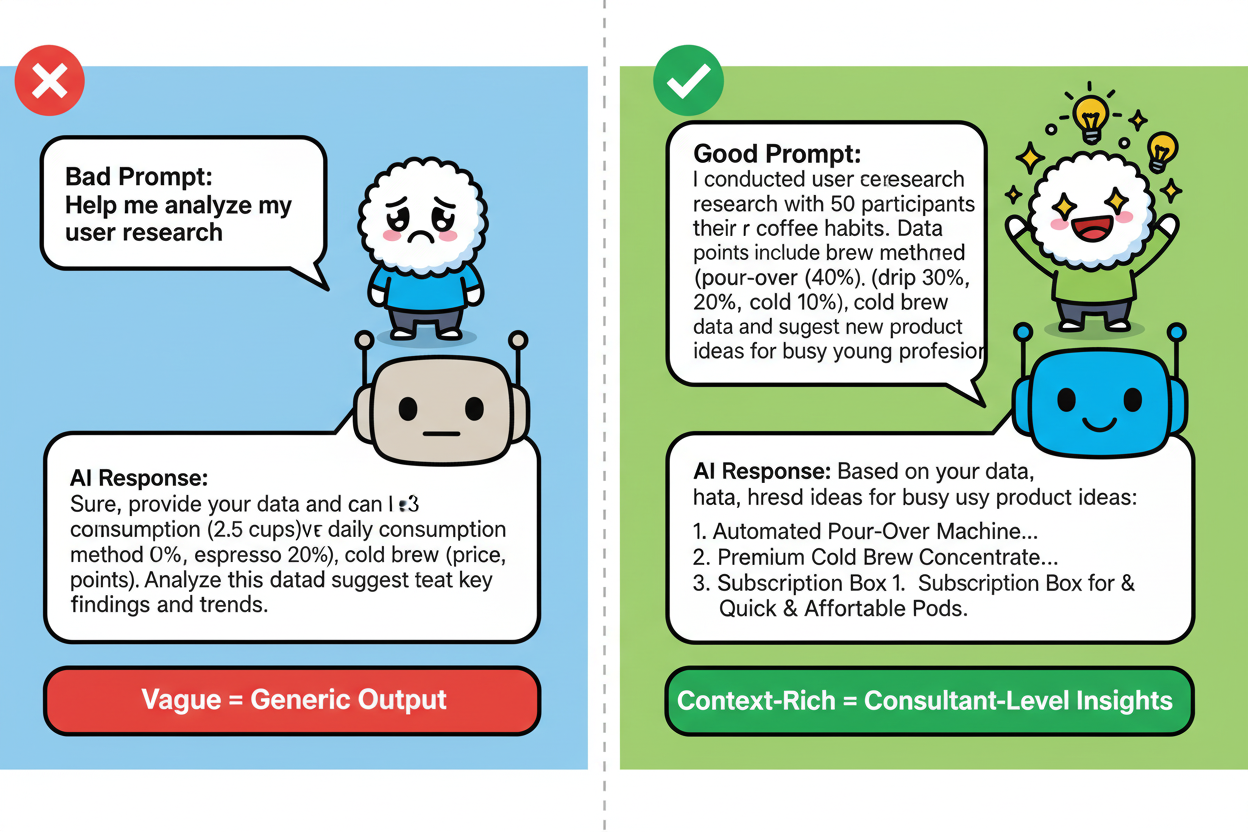
Here's where most people fail with AI: They ask vague questions and get vague answers.
❌ Bad prompt: "Help me analyze my user research."
✅ Good prompt: [Detailed prompt with full context...]
The difference? Context. The second prompt gives AI everything it needs to give you consultant-level insights.
[Continue with Claude's analysis, GPT-5's roadmap, Gemini's architecture...]
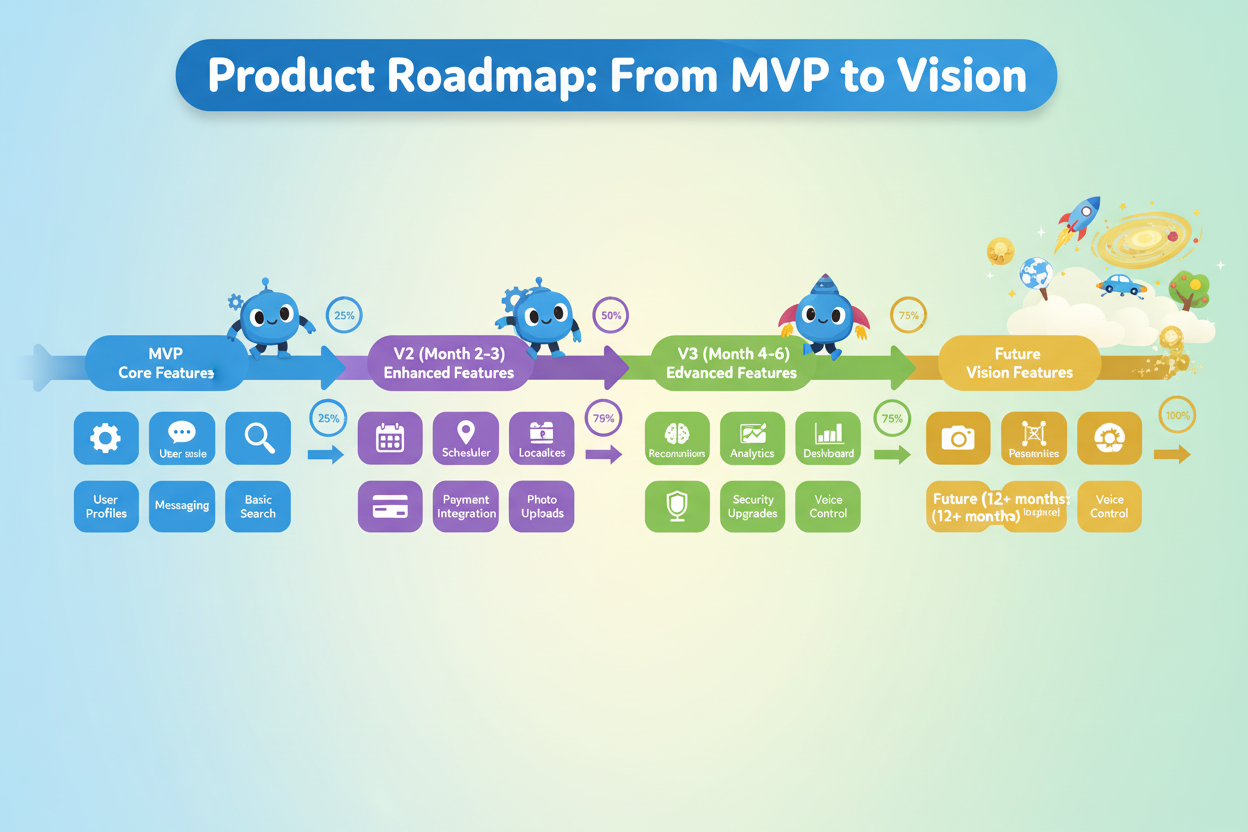
💡 Key Takeaway: Give AI clear roles and rich context. Then use YouMind to connect the dots between insights.
The 5-Step Framework + 3 Pitfalls to Avoid

After 11 days of intense AI-assisted product development, here's the repeatable framework:
🎯 The 5-Step AI Product Development Framework
Step 1: Multi-AI Validation + YouMind Synthesis
Step 2: AI-Designed Research + YouMind Organization
Step 3: AI Data Analysis + YouMind Pattern Recognition
Step 4: AI Product Design + YouMind Strategy Hub
Step 5: AI-Assisted Iteration + YouMind Knowledge Base
⚠️ 3 Pitfalls That Will Sink Your Project
Pitfall #1: Trusting a Single AI
Pitfall #2: Skipping Real User Validation
Pitfall #3: Drowning in Information Without a System

The Tools That Make This Possible
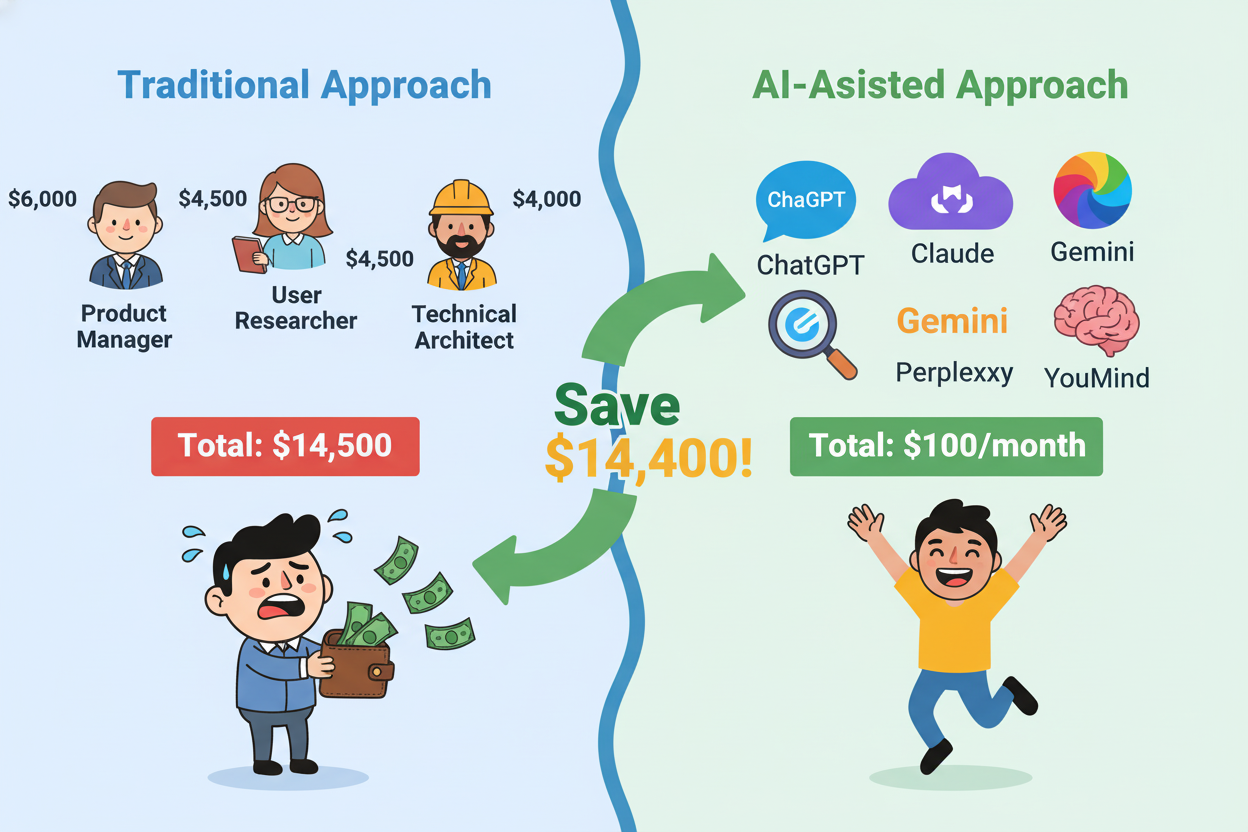
The AI Stack (Monthly Cost: ~$100)
For AI Conversations:
- ChatGPT Plus (GPT-5 access) - $20/month
- Claude Pro (Claude 4.5 access) - $20/month
- Gemini Advanced (Gemini 2.5 Pro access) - $20/month
- Perplexity Pro - $20/month
- DeepSeek - Free tier sufficient
- Grok (via X Premium) - $16/month
For Knowledge Management:
- YouMind - Your second brain for AI-assisted product development
Total: ~$100/month for AI tools + YouMind
ROI: Traditional approach would cost $14,500+ for 11 days. AI-assisted approach: $100.
Your Turn: Start Today, Not Someday
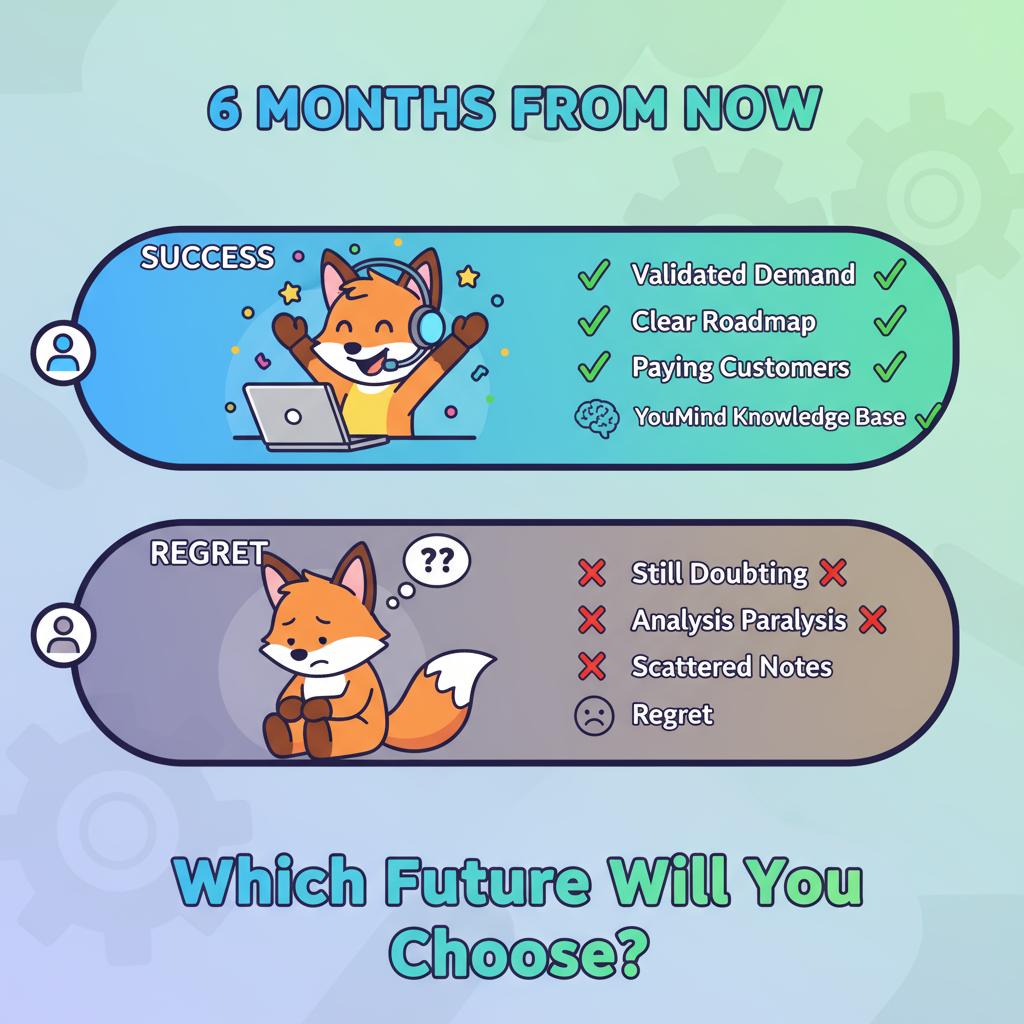
Close your eyes and imagine this:
Six months from now, you're launching your product. You have validated demand, a clear roadmap, paying customers, and all your knowledge organized in YouMind.
Or...
Six months from now, you're still thinking about your idea with doubts, analysis paralysis, and regret.
The difference between these two futures? Starting today.
Your First 90 Minutes (Do This Today)
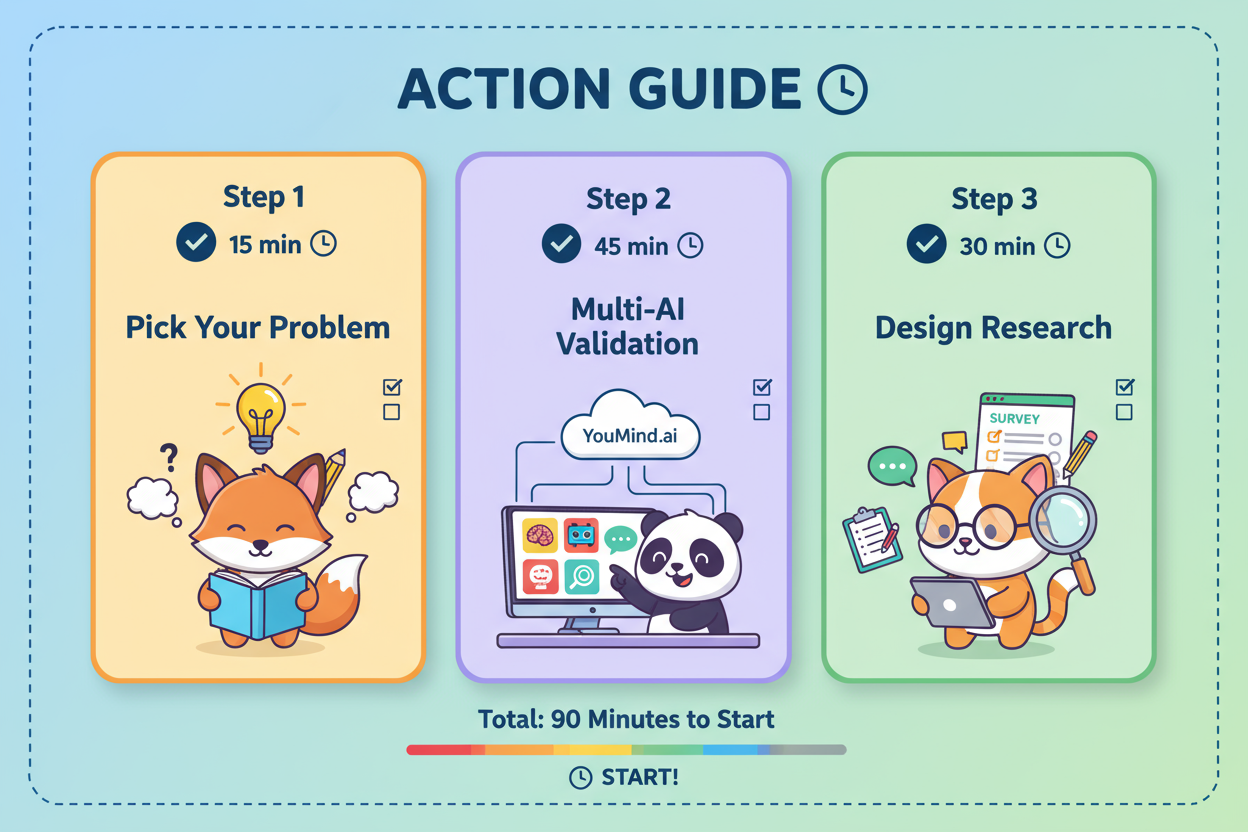
Action 1: Pick Your Problem (15 minutes)
Action 2: Run Multi-AI Validation (45 minutes)
Action 3: Design Your Research (30 minutes)
You're now 90 minutes in, and you're further along than 95% of people who "want to build something someday."
The Bottom Line
In the AI era, the barrier to building products isn't technical skill, money, or connections.
It's courage.
You have:
- ✅ AI tools that can play every role on your product team
- ✅ YouMind to manage insights and maintain context
- ✅ A proven framework (you just read it)
- ✅ Real examples (my 11-day journey)
The only question left is: Will you start?
This post is based on a real 11-day product development sprint. All data, user quotes, AI interactions, and insights are authentic.
Recommended tools: ChatGPT (GPT-5), Claude (4.5), Gemini (2.5 Pro), Perplexity, DeepSeek, Grok + YouMind
How I Built a Product from Scratch Using AI in 11 Days (And You Can Too)
Picture this: It's 11 PM in Tokyo. You're a freelance developer, and you just got a notification—a potential client from the US is asking detailed questions about your service on your website's contact form. This could be a $5,000 project. Maybe more.
